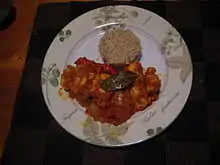Dopiaza
Dopiaza, alternatively spelled as two words, "Do Piaza/Pyaza", refers to a family of gravy-based Indo-Pakistani Mughlai recipes that use plenty of onions to add both body and flavor, with the onions cooked in two different ways and incorporated into the recipe at different times. The term means "with onions, two ways" in Hindustani: "Do"=two, the same root and pronunciation as in Spanish "dos"; "piaz"=onion, borrowed from Persian.
 | |
| Course | Main course |
|---|---|
| Main ingredients | Meat, onions, curry |

The dish's main ingredient can be a meat, e.g., beef, chicken or lamb [1] mutton, or shrimp. However, it can also be prepared in a vegetarian style, using potatoes or another starchy root vegetable, cauliflower, pressed fresh cottage cheese (paneer), or, non-traditionally, firm tofu. The term "Dopiaza" is used as a suffix - thus, we would have chicken dopiaza or paneer dopiaza. This usage, to indicate a shared technique, is similar to "gratin" in French cuisine to indicate a browned breadcrumbs + cheese crust, or "Bolognese" in Italian cuisine to indicate the use of a ground-meat-based sauce.
In a dopiaza dish, half the onions are blended into a paste, with aromatic spices, garlic, ginger, and a mild souring agent like tomato or yoghurt (or powdered unripe mango (aamchoor) or lemon/lime in Hyderabadi cuisine), and briefly cooked with a little oil until fragrant, before the main ingredient is added and the mixture cooked down further to form a thick gravy. The remaining onions are sliced and deep-fried until browned and crisp to serve as a topping, which is added to the dish just before serving.
While a Dopiaza dish contains plenty of onion, the etymological assertion in the Time-Life cookbook "Fresh Ways with Pork" that "Dopiaza, the Indian title of this dish, indicates that it contains twice the amount of onions as meat" [2] stems from a misunderstanding of Hindustani culinary terminology. (Also, the dopiaza recipes originated in South-Asian Muslim cuisine, where pork is forbidden.) Basu's explanation [1] of how the onions are prepared in two ways is the correct one.
History
According to the legend the style of recipe was created when a courtier of Mughal emperor Akbar, Mullah Do Piyaza, accidentally added a large quantity of onions to a meat dish. (However, this person is believed to be fictional: in any case, "onions two ways" would be a nickname rather a given name.)
The dishes evolved further in Hyderabad and other Muslim-culture locales in India, such as Awadh and Punjab, as well as neighboring Iran and, with the Indian diaspora, spread to many other countries.
Ingredients
In addition to onion, a souring agent is also used, as stated above. Non-traditional souring agents include dried pomegranate seed andcranberries. Basic ingredients for dopiaza are chicken or other meats, onions, ginger and garlic paste, whole hot spices (black cardamoms, cloves and peppercorns), salt and chili powder.
One form of Iranian Dopiaza is vegetarian, prepared using potatoes, onion, turmeric powder, tomato paste, dried fenugreek leaves, and spices.
Notes
References
- Basu, Mallika (16 December 2015). "Lamb Dopiaza: an alternative recipe for Christmas Day". Evening Standard. Retrieved 22 August 2019.
- Time-Life Books (1988). Fresh ways with pork. Healthy home cooking. Time-Life Books. ISBN 978-0-8094-6033-5. Retrieved 22 August 2019.
External links
| Wikimedia Commons has media related to Dopiaza. |


